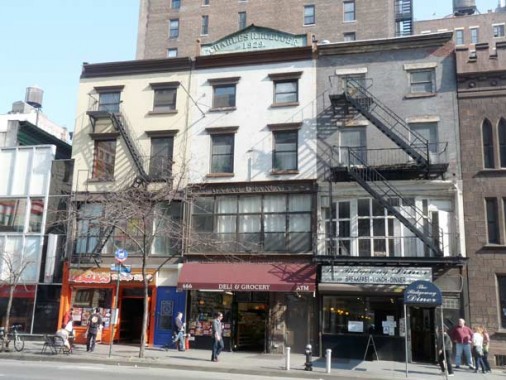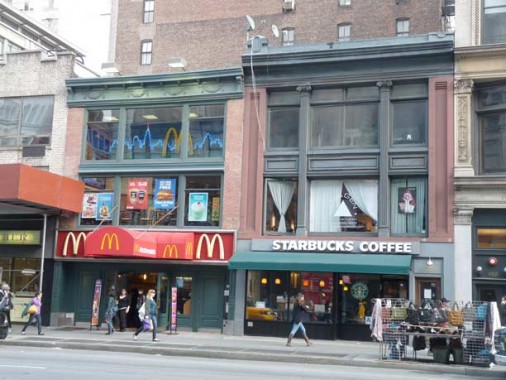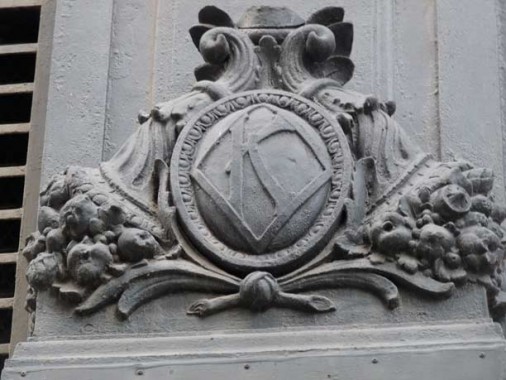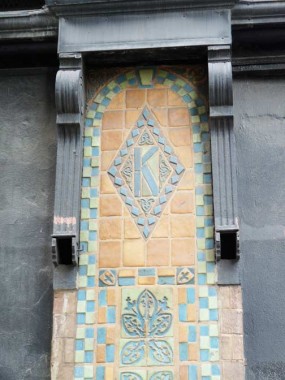6th Avenue between West 17th and 23rd Streets is known as the Ladies’ Mile, after the gigantic emporiums such as the Siegel-Cooper Building (now home to Bed, Bath and Beyond) and the original B. Altman Building that can be found on both sides of the street, attracting shoppers from all over the metropolitan area, that were built during the first 2 decades of the 20th Century.
Elsewhere on 6th Avenue, though, are remaining buildings from an even earlier era, from when 6th Avenue was first developed in the 1840s and 1850s. I have worked off and on in the area since the 1980s, and when I first arrived, the original Ladies’ Mile era was over — the big stores had moved uptown, the huge buildings had fallen into disrepair and decrepitude, and the region was home to garment wholesalers. In the late 1980s and into the 1990s, the cycle moved around again and the huge buildings again became home to large retail establishments.
One of the oldest remaining buildings on the stretch is the Limelight Marketplace, built in 1844 at 6th Avenue and West 20th as the Episcopal Church of the Holy Communion by famed architect Richard Upjohn. Of course many New Yorkers remember it in the 1980s and 1990s as a disco/drug supermarket.
A charming cluster of 4-story buildings can be found on the east side of 6th Avenue north of the Limelight between West 20th and 21st Streets. According to real estate records, they were built around 1850, in the years following the coming of the Episcopal Church to the area. In the middle is #666 6th, something of an ironic number considering the proximity of the old church.
A pair of pressed metal signs can be found on the pediment and above the second floor, noting the former Bazar Français and its owner, Charles R. Ruegger, which I imagine was pronounced “roo=ZHAY.” Though 1929 seems a little past the area for such signage, here’s a wonderfully preserved sample of the art.
According to Tom Miller’s excellent NYC site Daytonian in Manhattan, Ruegger had already been in business in NYC for 55 years, since 1874, by the time he moved his Bazar Français to 666 6th.
In March 1929 Ruegger purchased the building from Samuel and Nettie Lichtman. The Times reported that “It is to be extensively altered and occupied by Mr. Ruegger for his business of hotel, club and restaurant equipment.” Among the alterations was the removal of the unsightly fire escape to the rear of the building.
Around this time Ruegger opened a shop nearby on 19th Street for the manufacture industrial metal such as ducts and ventilators. The 78-year old Charles Ruegger died in 1931. He had not only created a successful business in the Bazar Francais but was mayor of Woodridge, New Jersey, for two consecutive terms. His son, Charles Jr., continued running the business.
After World War II the firm would produce its own line of copper and brass cookware. The Bazar Francais continued to offer imported kitchen ware as well as its own high-end goods, becoming the first gourmet outlet in the country. Along with small items like butter brushes, the firm offered decorative and hard-to-find articles like the 1956 nickel-plated wine rack “that completes the apartment dweller’s suburban-scorning life.”
Bazar Français closed in 1975 but the signs are still on the building, as well as one more additional artifact…
The “Bazar Français” painted ad on the north side of #668 is still there, a testament to the paint quality as well as only a few hours in the sun each day.
Between West 21st and West 22nd, there are a group of buildings of varying height, many of which are occupied by fast food joints. These two probably go back to the same era as the Ruegger building.
Finally, a look at one of my favorite buildings in the stretch, the old Ehrich Brothers Emporium on the west side of 6th between West 22nd and 23rd, that is festooned with my favorite letter in the alphabet on three sides in pressed metal and tile lettering, the type used in subway signage.
As explained on this FNY page, the K’s date to the era when the building was owned by Chicago merchants J.L. Kesner Company, who hired architects Taylor and Levi to add all the letter K’s in 1911. However Kesner was only in the building until 1913!
3/15/12










19 comments
Wasn’t the Episcopal Church of the Holy Communion a one time headquarters for listener sponored radio station WBAI(99.5FM)?
Posted on the ides of March, nice touch.
Really enjoyed this article! It really illustrates how New York neighborhoods continue to change over time. It is remarkable, too, how the uses for specific buildings change over the course of years. And the Limelight is a great example – as anyone who lived in lower Manhattan in the 1980’s can attest! Chelsea, NYC nid=4 is truly one of the city’s historic and beautiful neighborhoods. And it’s terrific that you’re keeping an eye on these all-too-often disappearing gems of NYC. Thank you!
Kool post Kevin. You could be throwing a shutout with all those K’s.
According to the 1920 Census, Old Chuck Ruegger (Roo-ger, with a hard “G”) was born in Switzerland in 1854/5. His wife’s name was Anna Catherine (also listed as Katrina). His occupation was listed as “retail hardware”. The Census indicates his residence as Bergen, New Jersey.
Here’s a picture of some of the merchandise he sold (Hope this works!):
http://images.cloud.worthpoint.com/wpimages/images/images2/1/0611/07/1_eb8d60ca11fbb768520af1b5f031e178.jpg
One more:
http://images.cloud.worthpoint.com/wpimages/images/images1/1/0611/07/1_eb8d60ca11fbb768520af1b5f031e178.jpg
Link didn’t work for me.
Try this one:
http://www.worthpoint.com/worthopedia/vintage-charles-rueggers-copper-159945339
Worthpoint seems to get touchy about linking to photos.
Why was this area known as Ladies’ Mile in the first place? Was it because the stores here were dedicated to women’s products? Could it have been known for when women were making their protests such as the right to vote? Just hearing this does get me a little puzzled to why it has such a name.
Big stores are often frequented by ladies.
And in the late 19th century, when the big, “all-inclusive” department stores were coming into vogue, they were just about the only places where respectable women could go without needing to be escorted by men.
Because in past times women did most of the shopping in this country.
Richard, the WBAI church was at 359 East 62nd, demolished for an apartment house.
The black and white curtain wall building on the left in the 1st and 6th photos was the union hall for Glazier’s Local 1087. I was a member from ’84-’91.
Sixth Avenue between 17th and 23rd is part of the modern Ladies’ Mile Historic District but in the 19th century, Ladies’ Mile itself was Broadway between Union Square and Madison Square, not 6th Avenue.
Although more than one web site gets this wrong, see:
http://http://www.preserve2.org/ladiesmile/
and
http://http://www.nyc-architecture.com/walks-LadiesMile.htm
among others.
I am late to the party on this one but—Recently did some family history research and discovered–helped by Google Street View—that many of the buildings my family had offices or factories in were in this area—23rd and around 7th—this was the Fur District in those days and they were importing and exporting and in the case of my family they were also doing things with dyed furs and one of the very –ahem–clever—names was Denit—break that down and stop laughing! We also had Van Dye Way which was a play on words of the family name Van de(n) Weghe. There were four or five buildings we had various business’ in–wonder how much we would be worth if we STILL had them? We still had them in the Mid-1960’s. When this was–er–not Chelsea as we know it!
An odd interesting “Forgotten” sort of thing–I have a painting from Belgium of what I was always told was the Van Den Weghe’s family home in a tiny village in Vlandern (Flanders). This town is quite near Ypres and was at the epicenter of fighting during several wars including of course WWI and WWII. Recently I used Google Street view to go see what I could find there. I used the address of the Church as seen in the painting and astonishingly got a view that was almost identical to the view in the 1893 painting! The Church; the tiny ancient buildings across the road from where the easel must have been placed—I decided to “Tour around” the village and first did a circle–to actually shout out loud–the building to the REAR of the street view–where the painting would have been done from–had large friendly letters spelling out the family name–and the business–which is STILL furriers. The facade of the building has a more modern siding but the old original bricks can still be seen. So–the family “legend” was—true. There we were—over 110 years later in the SAME ancient building; with the SAME buildings across the street–Now all I need to do is jaunt off to Belgium and knock on the door! Or maybe just get Google Translate to help me do an email—
And the artist? Yeah he turns out to be pretty famous actually! You just never know.
Doesn’t the Old Club Limelight hold the 666 address?
Just had lunch at a restaurant opposite of no 666 and wondered what the Bazar Francais sign was. Thanks for explaining!
I had the pleasure of selling Mr. Ruegger, Jr. his life insurance coverage in the early 1960’s (New England Mutual) and visited him at his home in Teterboro NJ and at the store on 6th ave., many times. I loved visiting him at that store!